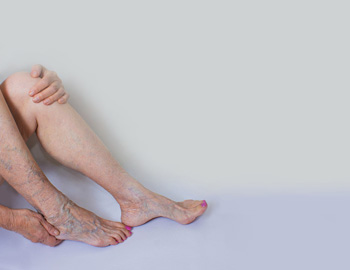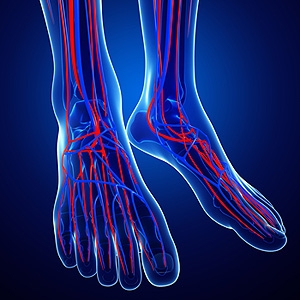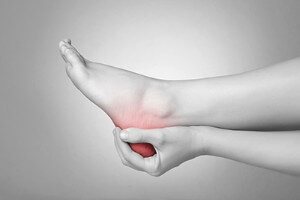Oceanside (760) 630-9200

What Is a Doppler Ultrasound Used For?
 In podiatry, vascular testing is used to evaluate the circulation in your feet and ankles and to screen for peripheral artery disease, a condition that causes poor circulation to the lower limbs. Vascular testing is generally noninvasive and painless. One common tool that podiatrists use in vascular testing is a Doppler ultrasound. A Doppler ultrasound uses high-frequency sound waves to measure the amount of blood flow through your arteries and veins. During the test, a gel will be placed on a handheld device called a transducer, and your podiatrist will then move the device against the skin of your ankles and feet. The high-frequency sound waves emitted by the device allow it to create images of your blood flow on a computer, which are then examined to determine whether or not there are any problems with your circulation. To learn more about Doppler ultrasounds and other vascular tests, consult with a podiatrist today.
In podiatry, vascular testing is used to evaluate the circulation in your feet and ankles and to screen for peripheral artery disease, a condition that causes poor circulation to the lower limbs. Vascular testing is generally noninvasive and painless. One common tool that podiatrists use in vascular testing is a Doppler ultrasound. A Doppler ultrasound uses high-frequency sound waves to measure the amount of blood flow through your arteries and veins. During the test, a gel will be placed on a handheld device called a transducer, and your podiatrist will then move the device against the skin of your ankles and feet. The high-frequency sound waves emitted by the device allow it to create images of your blood flow on a computer, which are then examined to determine whether or not there are any problems with your circulation. To learn more about Doppler ultrasounds and other vascular tests, consult with a podiatrist today.
Vascular testing plays an important part in diagnosing disease like peripheral artery disease. If you have symptoms of peripheral artery disease, or diabetes, consult with Dr. Jeff Brooks from Oceanside Foot & Ankle Center. Our doctor will assess your condition and provide you with quality foot and ankle treatment.
What Is Vascular Testing?
Vascular testing checks for how well blood circulation is in the veins and arteries. This is most often done to determine and treat a patient for peripheral artery disease (PAD), stroke, and aneurysms. Podiatrists utilize vascular testing when a patient has symptoms of PAD or if they believe they might. If a patient has diabetes, a podiatrist may determine a vascular test to be prudent to check for poor blood circulation.
How Is it Conducted?
Most forms of vascular testing are non-invasive. Podiatrists will first conduct a visual inspection for any wounds, discoloration, and any abnormal signs prior to a vascular test.
The most common tests include:
- Ankle-Brachial Index (ABI) examination
- Doppler examination
- Pedal pulses
These tests are safe, painless, and easy to do. Once finished, the podiatrist can then provide a diagnosis and the best course for treatment.
If you have any questions, please feel free to contact our office located in Oceanside, CA . We offer the newest diagnostic and treatment technologies for all your foot care needs.
Vascular Testing in Podiatry
In foot care, vascular testing may be required in the diagnosing and treatment of certain podiatric conditions. Vascular testing is particularly relevant for patients with high-risk diabetes, poor circulation, peripheral artery disease (PAD), and chronic venous insufficiency (CVI). Procedures typically involve the examination of blood vessels throughout the body for blockages or buildup.
Vascular testing is very important for the diagnosis of various conditions, including peripheral artery disease and chronic venous insufficiency, as these conditions can greatly affect one’s quality of life and cause pain in the lower limbs. Circulatory problems in the feet and ankles can reflect issues throughout the body, making testing of the blood vessels pertinent.
Testing methods vary between practitioners and can be specific to certain foot and ankle problems. Modern technology has brought about the ability to perform vascular testing using non-invasive methods, such as the cuff-based PADnet testing device. This device records the Ankle-Brachial Index (ABI)/Toe-Brachial Index (TBI) values and Pulse Volume Recording (PVR) waveforms. Contact your podiatrist to determine what vascular testing is available for your needs.
Are You Suffering From Ingrown Toenails?
Injections for Plantar Fasciitis
 Plantar fasciitis is a foot condition caused by inflammation of the plantar fascia, a band of tissue that runs along the bottom of the foot. The most common symptom of plantar fasciitis is a sharp pain in the foot. There are multiple treatment options for plantar fasciitis depending on the severity of your condition. In more severe cases, where other treatment options have had minimal success, injections into the foot may provide relief. Cortisone injections can reduce or eliminate inflammatory pain. Platelet rich plasma (PRP) injections use platelets from your own blood to promote healing in damaged tissue. If you have plantar fasciitis, please consult with a podiatrist to find the right treatment for you.
Plantar fasciitis is a foot condition caused by inflammation of the plantar fascia, a band of tissue that runs along the bottom of the foot. The most common symptom of plantar fasciitis is a sharp pain in the foot. There are multiple treatment options for plantar fasciitis depending on the severity of your condition. In more severe cases, where other treatment options have had minimal success, injections into the foot may provide relief. Cortisone injections can reduce or eliminate inflammatory pain. Platelet rich plasma (PRP) injections use platelets from your own blood to promote healing in damaged tissue. If you have plantar fasciitis, please consult with a podiatrist to find the right treatment for you.
Plantar fasciitis can be very painful and inconvenient. If you are experiencing heel pain or symptoms of plantar fasciitis, contact Dr. Jeff Brooks from Oceanside Foot & Ankle Center. Our doctor can provide the care you need to keep you pain-free and on your feet.
What Is Plantar Fasciitis?
Plantar fasciitis is the inflammation of the thick band of tissue that runs along the bottom of your foot, known as the plantar fascia, and causes mild to severe heel pain.
What Causes Plantar Fasciitis?
- Excessive running
- Non-supportive shoes
- Overpronation
- Repeated stretching and tearing of the plantar fascia
How Can It Be Treated?
- Conservative measures – anti-inflammatories, ice packs, stretching exercises, physical therapy, orthotic devices
- Shockwave therapy – sound waves are sent to the affected area to facilitate healing and are usually used for chronic cases of plantar fasciitis
- Surgery – usually only used as a last resort when all else fails. The plantar fascia can be surgically detached from the heel
While very treatable, plantar fasciitis is definitely not something that should be ignored. Especially in severe cases, speaking to your doctor right away is highly recommended to avoid complications and severe heel pain. Your podiatrist can work with you to provide the appropriate treatment options tailored to your condition.
If you have any questions please feel free to contact our office located in Oceanside, CA . We offer the newest diagnostic and treatment technologies for all your foot and ankle needs.
Plantar Fasciitis
Plantar fasciitis is one of the most common causes of heel pain. The plantar fascia is the thick band of tissue that connects the heel bone to the toes. When this band of connective tissue becomes inflamed, plantar fasciitis occurs. Fortunately, this condition is treatable.
There are several factors that may put you at a greater risk for developing plantar fasciitis. One of the biggest factors is age; plantar fasciitis is common in those between the ages of 40 to 60. People who have jobs that require them to be on their feet are also likely to develop plantar fasciitis. This includes factory workers, teachers, and others who spend a large portion of their day walking around on hard surfaces. Another risk factor is obesity because excess weight can result in extra stress being placed on the plantar fascia.
People with plantar fasciitis often experience a stabbing pain in the heel area. This pain is usually at its worst in the morning, but can also be triggered by periods of standing or sitting. Plantar fasciitis may make it hard to run and walk. It may also make the foot feel stiff and sensitive, which consequently makes walking barefoot difficult.
Treatment for plantar fasciitis depends on the severity of the specific case of the condition. Ice massage applications may be used to reduce pain and inflammation. Physical therapy is often used to treat plantar fasciitis, and this may include stretching exercises. Another treatment option is anti-inflammatory medication, such as ibuprofen.
If you suspect that you have plantar fasciitis, meet with your podiatrist immediately. If left untreated, symptoms may lead to tearing and overstretching of the plantar fascia. The solution is early detection and treatment. Be sure to speak with your podiatrist if you are experiencing heel pain.
Foot Care for the Elderly
 The feet are the foundation of our bodies, and as such, caring for the feet is very important. This is especially true for older people, who are more prone to various foot problems, such as dry skin, calluses, corns, blisters, ingrown toenails, and infections. A daily foot care routine can help prevent some of these conditions. Each day, clean both feet with warm water and then dry them thoroughly, including the areas between the toes, to avoid bacterial and fungal infections. Apply lotion to the feet to prevent dryness. Trim toenails straight across and not too close to the nail bed to minimize the risk of developing an ingrown toenail. Complete light daily exercise and wear shoes when walking to strengthen the feet and prevent injury. For more information on caring for elderly feet, consult with a podiatrist.
The feet are the foundation of our bodies, and as such, caring for the feet is very important. This is especially true for older people, who are more prone to various foot problems, such as dry skin, calluses, corns, blisters, ingrown toenails, and infections. A daily foot care routine can help prevent some of these conditions. Each day, clean both feet with warm water and then dry them thoroughly, including the areas between the toes, to avoid bacterial and fungal infections. Apply lotion to the feet to prevent dryness. Trim toenails straight across and not too close to the nail bed to minimize the risk of developing an ingrown toenail. Complete light daily exercise and wear shoes when walking to strengthen the feet and prevent injury. For more information on caring for elderly feet, consult with a podiatrist.
Proper foot care is something many older adults forget to consider. If you have any concerns about your feet and ankles, contact Dr. Jeff Brooks from Oceanside Foot & Ankle Center. Our doctor can provide the care you need to keep you pain-free and on your feet.
The Elderly and Their Feet
As we age we start to notice many changes in our body, but the elder population may not notice them right away. Medical conditions may prevent the elderly to take notice of their foot health right away. Poor vision is a lead contributor to not taking action for the elderly.
Common Conditions
- Neuropathy – can reduce feeling in the feet and can hide many life-threatening medical conditions.
- Reduced flexibility – prevents the ability of proper toenail trimming, and foot cleaning. If left untreated, it may lead to further medical issues.
- Foot sores – amongst the older population can be serious before they are discovered. Some of the problematic conditions they may face are:
- Gouging toenails affecting nearby toe
- Shoes that don’t fit properly
- Pressure sores
- Loss of circulation in legs & feet
- Edema & swelling of feet and ankles
Susceptible Infections
Diabetes and poor circulation can cause general loss of sensitivity over the years, turning a simple cut into a serious issue.
If you have any questions please feel free to contact our office located in Oceanside, CA . We offer the newest diagnostic and treatment technologies for all your foot and ankle needs.
Elderly Foot Care
As you grow older, you will start to notice more problems with your feet due to wear and tear. This may also happen because the skin will start to become thin and lose elasticity. Some signs of aging feet are regular aches and pains, bunion development, and clawed toes.
Fortunately, there are ways you can improve comfort, relieve pain, and maintain mobility in your feet. One of the best ways to deal with aging feet is to exercise. If you keep active, your muscles will become toned which will then strengthen the arches in the foot and stimulate blood circulation.
It is important that you practice proper foot care to protect your aging feet. You should wash your feet in warm water on an everyday basis. Afterward, the feet need to be dried well and it is important to dry between the toes. Your toenails should be trimmed and kept under control; nails that are poorly cut may become ingrown. At the end of each day, performing an inspection of your feet will allow you to detect any ailments in their early stages.
As you grow older, it becomes more important that you wear comfortable shoes. Your shoes should be secure, and they should provide decent arch support. If you are looking to buy a new pair of shoes, it is best to look for a pair that are made from a breathable material. It is also helpful to have shoes that have a bit of extra room at the top of the shoe, especially if you suffer from swollen feet.
The most common foot problems that elderly people will encounter are bunions, calluses, corns, hammertoes, heel pain, and foot problems related to diabetes. Some other issues include arch pain, tarsal tunnel syndrome, Achilles tendonitis, and Morton’s neuroma
An annual foot examination is a great way for you to ensure that you do not have any serious health problems with your feet. You should talk to a podiatrist about the available treatment options for whichever foot issue you are dealing with.
Why Live with Pain and Numbness in Your Feet?
Prior Ankle Sprains Can Make Future Ones More Likely
 A recent review of studies on ankle injuries found that ankle sprains are one of the most common musculoskeletal injuries, affecting approximately 2 million people in the United States each year. Ankle sprains are especially common amongst athletes. However, about half of all acute ankle sprains treated in emergency departments across the country did not occur during a sporting activity. This review also found that many people with acute ankle sprains reported that they had a history of ankle sprains in the past, suggesting that spraining your ankle once makes you more likely to sprain it again in the future. Because of this, injury prevention is very important. Strengthening the muscles and improving biomechanics of the lower limbs may help prevent ankle sprains. If you have sprained your ankle, it is recommended that you see a podiatrist for treatment.
A recent review of studies on ankle injuries found that ankle sprains are one of the most common musculoskeletal injuries, affecting approximately 2 million people in the United States each year. Ankle sprains are especially common amongst athletes. However, about half of all acute ankle sprains treated in emergency departments across the country did not occur during a sporting activity. This review also found that many people with acute ankle sprains reported that they had a history of ankle sprains in the past, suggesting that spraining your ankle once makes you more likely to sprain it again in the future. Because of this, injury prevention is very important. Strengthening the muscles and improving biomechanics of the lower limbs may help prevent ankle sprains. If you have sprained your ankle, it is recommended that you see a podiatrist for treatment.
Although ankle sprains are common, they aren’t always minor injuries. If you need your ankle injury looked at, contact Dr. Jeff Brooks from Oceanside Foot & Ankle Center. Our doctor can provide the care you need to keep you pain-free and on your feet.
How Does an Ankle Sprain Occur?
Ankle sprains are the result of a tear in the ligaments within the ankle. These injuries may happen when you make a rapid shifting movement while your foot is planted. A less common way to sprain your ankle is when your ankle rolls inward while your foot turns outward.
What Are the Symptoms?
- Pain at the sight of the tear
- Bruising/Swelling
- Ankle area is tender to touch
- In severe cases, may hear/feel something tear
- Skin discoloration
Preventing a Sprain
- Wearing appropriate shoes for the occasion
- Stretching before exercises and sports
- Knowing your limits
Treatment of a Sprain
In many cases, the RICE method (Rest, Ice, Compression, and Elevate) is used to treat ankle sprains. However, you should see a podiatrist to see which treatment option would work best with your injury. In severe cases, surgery may be required.
It is important to ask your doctor about rehab options after you receive treatment for your injury. Stretching, strength training, and balance exercises may help the ankle heal while also preventing further injury.
If you have any questions, please feel free to contact our office located in Oceanside, CA . We offer the newest diagnostic and treatment technologies for all your foot care needs.














